|
In this Issue...
- 28th Annual IBNS Conference at a Glance
- And…they’re off! My unique research experience teaching rats to drive a car
- Growing Up With IBNS
- Science Down Under
28th Annual IBNS Conference at a Glance
Julianne Jett, PhD
Chair, IBNS Membership & Communications Committee
Planning the IBNS Annual Conference requires endless hours of teamwork and timely coordination by our committee members and administrative staff located around the world. Their dedication to promoting behavioral neuroscience and a collaborative scientific community is evident by the conference reaching new heights each year. Be it the quality of research presented at symposia, number of members in attendance, opportunities for networking, or the meeting destination, IBNS is sure not to disappoint!
The 28th Annual Conference in Cairns, Australia, kept this tradition alive with 22 countries in attendance, proof of IBNS’ growing international reach. Of those attending, 54% were faculty and 46% trainees (undergraduate, graduate, and postdoctoral). The high trainee turnout at this year’s meeting is a testament to the organizations’ continued efforts to recruit and support young scientists through local outreach efforts, competitive travel awards (25 in total) and career development opportunities. One of the highly anticipated trainee-focused events is the annual poster competition, which had 97 entries at this year’s meeting. We would like to congratulate the 2019 poster competition winners, to include Leigh Walker for the Postdoctoral Best Poster Award, Mariela Faykoo-Martinez for the Graduate Best Poster Award, and a tie between Danielle LeServe and Skylar Lambert for the Undergraduate Best Poster Award - Well done! We would also like to thank Patricia de la Tremblaye, IBNS Student Council Representative, for organizing the event, as well as a debt of gratitude to the faculty members that volunteered their time as poster judges.
In addition to announcing the travel awardees and poster competition winners at the end-of-meeting Awards Ceremony and Banquet, IBNS recognized key faculty members for their significant contributions to the Society and/or field of study. This year’s Early Career Achievement Award went to Zackary Cope in recognition of his noteworthy contributions to the field of behavioral neuroscience within seven years of receiving his doctorate degree. For their significant contributions/service to IBNS and respective fields of study, this year's Fellow Award recipients were Corina Bondi and Elizabeth Brynes. Additionally, in recognition of his outstanding professional achievements in the field of behavioral neuroscience, Robert Gerlai was presented the Career Achievement Award. Congratulations to you all, the recognition is beyond deserved! We would like to thank our Nominations & Awards Committee (Chair, F. Scott Hall), as well as the Education and Training Committee (Chair, Corina Bondi), for recruiting resources and selecting this year’s awardees.
Lastly, IBNS would like to give a tremendous ‘thank you’ to the Program Committee (Chair, Farida Sohrabji) the Local Organizing Committee (Chair, Stephen Kent), and our office administration (Marianne Van Wagner and Eve Van Wagner) for working tirelessly to organize an outstanding conference. Also, thank you the 28th IBNS Annual Conference sponsors for supporting the professional development of our trainees by providing funds for travel awards, workshops and networking events. Those sponsors include Elsevier, Stoelting, ThorLabs, RWD Life Science, The Florey, University of Sydney/Brain and Mind Centre, Plexon, Lafayette Instrument, San Diego Instruments, Noldus, and Hellobio. For more conference highlights, including a complete list of awardees, please visit the 28th IBNS Annual Conference Highlights page https://www.ibnsconnect.org/2019-ibns-highlights.
 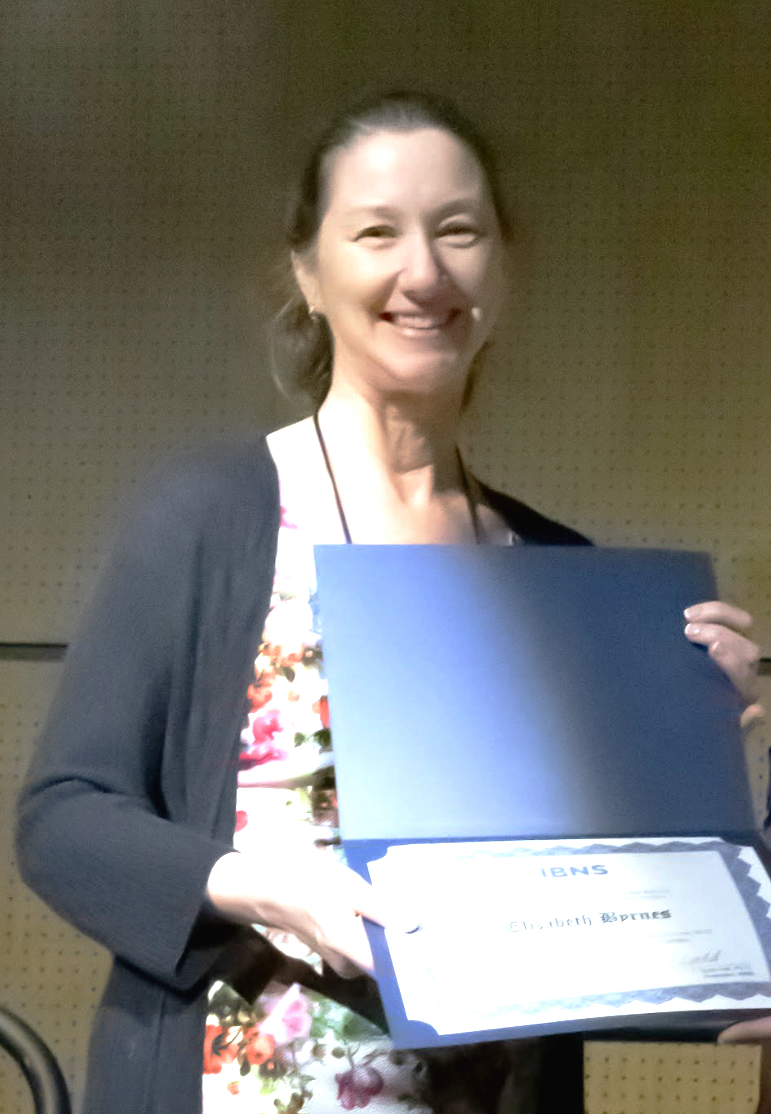 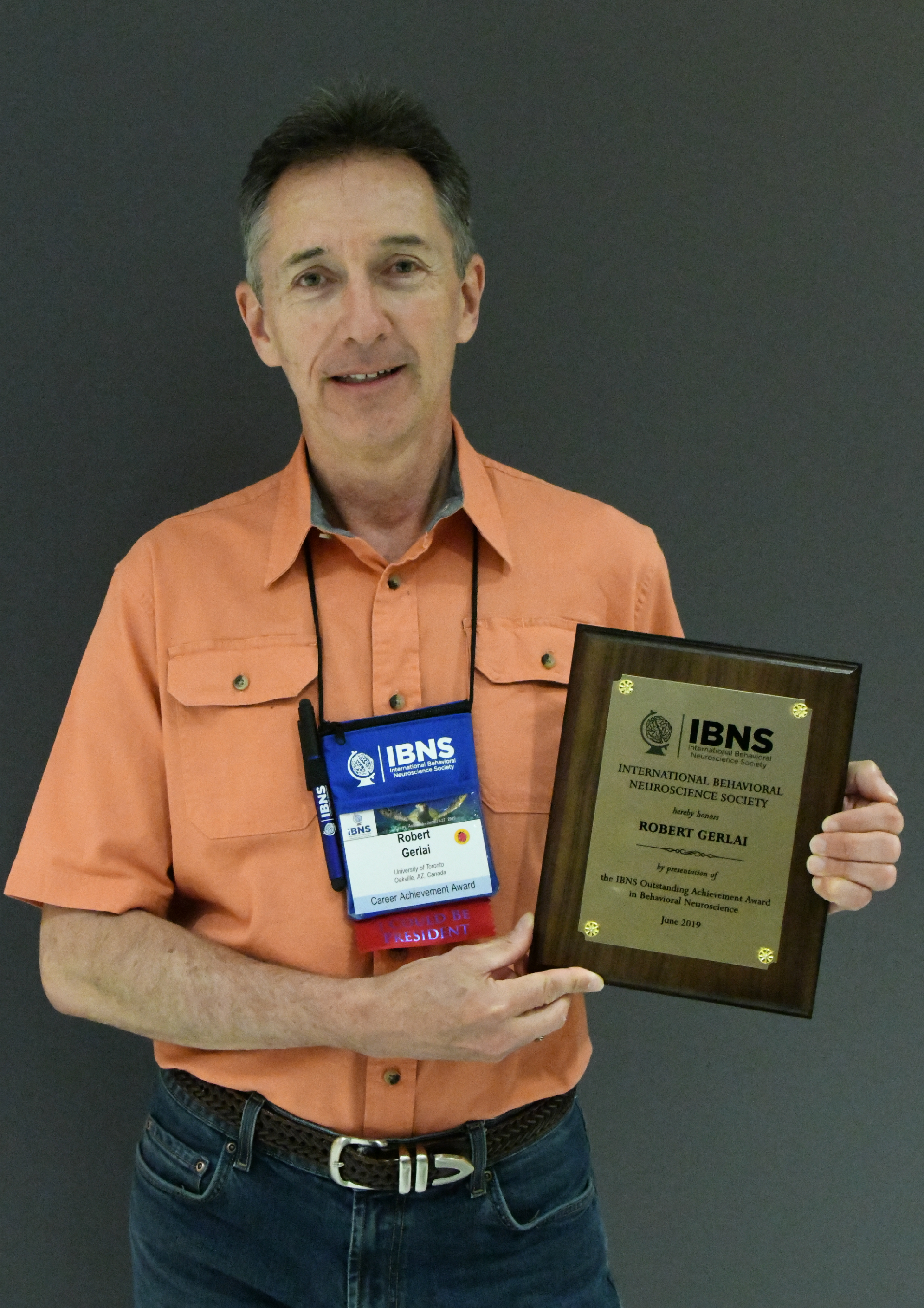
Photo Description: On the left, Zackary Cope (University of California San Diego, USA) was awarded the Early Career Achievement Award. On the right, Robert Gerlai (University of Toronto Mississauga, Canada) was awarded the Outstanding Achievement Award in Behavioral Neuroscience. Center, Elizabeth Byrnes (Tufts University, USA) was honored as a Fellow of IBNS. Below is a photo of the 2019 travel awardees. A complete list of awardees can be found on the 28th IBNS Annual Conference Highlights page https://www.ibnsconnect.org/2019-ibns-highlights.

Back to Top
Editor/Guest: Davide
Neuroscientists at IBNS study behavior using classical paradigms. Pushing the envelope on this concept, Danni LeServe describes a very interesting model of sophisticated learning in which animals learn to operate a vehicle.
And…they’re off! My unique research experience teaching rats to drive a car
Danni LeServe, University of Richmond
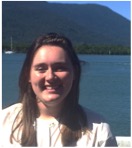 I heard about the rat car driving project when I first joined Dr. Lambert’s lab during my junior year and saw that another student, Nate Fox, was finishing an exploratory training project with two rats named Mario and Luigi (after the racing characters in the video game series). Initially, the idea for this driving research came from Dr. Beth Crawford, a cognitive scientist at the University of Richmond, who approached Dr. Lambert with a simple question---Kelly, can you teach a rat to drive a car? After some laughter, Dr. Lambert realized Dr. Crawford was serious and they discussed what could be learned from determining if rats could acquire this artificial response and, further, what the rat car (or rodent-operated vehicle; ROV) should look like. Once the project was in full gear, I was fortunate to be asked to join the project as a student researcher. I was thrilled to receive a research grant from the University of Richmond to support my own driving study with a new group of rats. Honestly, however, I was simultaneously excited and nervous because I wasn’t sure I could train rats to drive a car. I heard about the rat car driving project when I first joined Dr. Lambert’s lab during my junior year and saw that another student, Nate Fox, was finishing an exploratory training project with two rats named Mario and Luigi (after the racing characters in the video game series). Initially, the idea for this driving research came from Dr. Beth Crawford, a cognitive scientist at the University of Richmond, who approached Dr. Lambert with a simple question---Kelly, can you teach a rat to drive a car? After some laughter, Dr. Lambert realized Dr. Crawford was serious and they discussed what could be learned from determining if rats could acquire this artificial response and, further, what the rat car (or rodent-operated vehicle; ROV) should look like. Once the project was in full gear, I was fortunate to be asked to join the project as a student researcher. I was thrilled to receive a research grant from the University of Richmond to support my own driving study with a new group of rats. Honestly, however, I was simultaneously excited and nervous because I wasn’t sure I could train rats to drive a car.
Along with Dr. Lambert and Dr. Crawford, we designed a study to compare rats that had learned to drive, which we referred to as the driver rats, with rats that never learned to drive but experienced the same motion and distance traveled in the car by using a remote control to move the car. We referred to the passive driving group as the Uber rats.
After the cars were built, we began our project with 12 female rats (n=6 for each group). I quickly embarked on a journey of intense behavioral conditioning---complete with habituation, shaping and rewarded trials—just as I had learned about in my Introduction to Psychology course. We started by handling our rats, habituating them to froot loop cereal pieces for rewards, and placing a plastic car base in their home cages to acclimate them to entering the car (which was voluntary in this study). We then began the driving protocol. This month-long process shaped the animals to contact the copper wires to activate the car and then maintain contact to drive to their reward station. Thus, the final phase was long-distance driving where the rats were only rewarded for driving to the end of the arena. The Driver and Uber rats were yoked to keep the distance traveled in the car consistent between groups.
Although this work was exciting, it certainly came with difficulties. The early training phases were challenging as rats revealed individual differences in training performance with some taking a long time to get with the driving program. It was also frustrating that, after conducting immunocytochemistry, we were unable to detect changes in markers of neuroplasticity or activation in the targeted brain areas. Dr. Lambert reminded me that this is the way research is…every investigation doesn’t lead to a significant p value! The results were more interesting when we looked at fecal stress hormone metabolites and saw that the Driver rats had a higher DHEA/CORT ratio than the Uber rats. Since higher DHEA/CORT ratios are consistent with emotional resilience, maybe the acquisition of the driving skill contributed to resilience in a similar way that effort-based rewards have been shown to do in our lab.
During my senior year, I continued with the rat driving project. Working with another UR psychologist, Dr. Laura Knouse, we designed a new project to determine the impact of an enriched environment on the acquisition of driving skills. We used the same protocol as the previous project except, due to our busy schedules during the academic year, we were only able to train the animals 3 times a week instead of 5 times per week. The results of this study are still being processed but we were surprised to learn that the rats housed in the standard cages didn’t exhibit learning in the task---only the enriched animals mastered driving the ROV. This was a valuable reminder that the housing environment of an animal has a strong influence on learning ability and neuroplasticity.
This research experience has taught me that it is sometimes valuable to be a little creative in neuroscience research and that pushing the upper limits of the animals’ learning abilities may offer new opportunities for research. Perhaps the best part of the research, however, was that it provided me with an opportunity to attend IBNS last month and present our findings to other neuroscientists. Additionally, I was honored to have been recognized for my poster presentation at the IBNS banquet. As a recent graduate from the University of Richmond, I am eager to see where this research journey will take me as I explore options for graduate school.
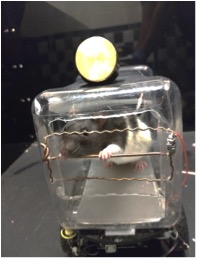 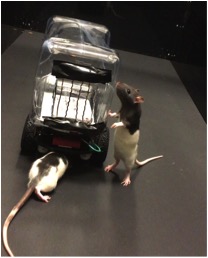
Picture Description: The original driving rats, Mario and Luigi, exploring their ROV (left) and an example of a rat contacting the copper bars (which were changed to a horizontal orientation in ROV upgrades) to drive the electric car to the reward destination (right).
Back to Top
May Newsletter vol 23-5 Guest Editor:

Julianne Jett, PhD
University of Texas at San Antonio
San Antonio, TX, USA
Thank you, Julianne!
Interested in serving as a Guest Editor for the IBNS News?
Email: [email protected]
Looking for a New Employment Opportunity or Struggling to Find the Right Candidate? Meet the IBNS Career Center!
One of the biggest challenges for any international scientific society is to provide quality and informative support to its members, whether it's for a new employment opportunity or finding the right candidate for a newly opened position. The IBNS online Career Center portal (http://jobs.ibnsconnect.org) provides the right tools for both job seekers and employers.

The IBNS Career Center portal offers all the standard operational features; such as a thorough search engine by keyword and location, as well as a free review of your resume for feedback, and a job-posting service for employers. However, what makes the IBNS Career Center stand out in terms of support is two additional quality features: resources for job seekers & access to a resume bank for employers.

In the Resources section, you have access to a number of articles with valuable tips in building a resume, job seeking, and communication. These tips come from experienced scientists in the field -- not only for searching or applying for a position, but also for the interview process. Interested in 'building your brand’ or strengthening your social media presence? You will find plenty of advice and tips to do so, which will help strengthen your image and move your career to the direction you want!
In the Resume Bank, potential employers have free access to a large bank of resumes and profiles. You can customize the filters that apply to your search and create lists of candidates that fulfill your own criteria.
Back to Top
Editor/Guest: Davide
Skylar, the daughter of former IBNS president Dr. Kelly Lambert, describes how she began her neuroscience education very early in life.
Growing Up With IBNS
Skylar Lambert, Furman University
IBNS and I go way back. I attended my first meeting in utero when my very pregnant mother, Kelly Lambert, attended the meeting in Denver, CO in 1997. Since that early introduction, I have been to eight IBNS conferences, located in five different countries. For seven of the eight conferences that I attended, I, along with my dad and older sister, got to explore the destination while mom attended symposia, poster sessions and keynote lectures for nearly four days straight. However, the most recent IBNS meeting in Cairns, Australia, was different. I finally got a taste of what it meant to attend the society as a budding neuroscientist. It wasn’t until this year that I had the opportunity to view IBNS as a professional/ academic endeavor rather than a way to travel to fun destinations.
For as long as I can remember, I have been intrigued by my mom’s career. As a child, I would continuously beg her to take me to the lab with her on my days off from school. I’d sit amongst the undergraduates in the lab feeling quite important, even though I was conducting rather mundane tasks that would be difficult to screw up. Even so, I was contributing to the field of neuroscience through my dedication to cage cleaning, cage card labeling, and lab organization (aka, cleaning up the lab). As I grew up, I continued to visit the lab, and by my senior year of high school, I was conducting my own neuroscience research in the Lambert lab. My 10-week summer research project, Highway FROM the Danger Zone: An Investigation of Post Traumatic Stress Disorder (PTSD)-like Biomarkers in Female Rats, allowed me to present my findings at a local conference. I thought this was a big deal at the time and never imagined I would have an opportunity to present a different research project at an international conference in a few years.
Once I arrived at Furman University, I still had a passion for pursuing neuroscience research even though I was a pre-med student. In my freshman year Foundations of Biology course, my professor, Dr. Linnea Freeman, introduced her exciting research in the neuroscience field, and I knew immediately that I wanted to join her lab. So, after working hard in her class and proving myself, I was asked to join Dr. Freeman’s lab! I was able to apply all of the foundational skills that I learned from my mom in another laboratory setting. However, this time, it felt great to be conducting research on my own (well, under the supervision of someone other than my mom). Around the time that I was accepted into the lab, I did a little research of my own and discovered that IBNS was going to be held in Australia in 2019. Immediately, I knew I needed to begin scheming. If I could conduct my project, collect preliminary findings, and make a case to the Furman Student Travel Committee to fund my travel, maybe I too would be able to present at IBNS like my biggest role model. I spent nearly a year working on the first phase of a multi-institutional, longitudinal project entitled: Establishing an In-Utero Valproic Acid Model of Autism and Evaluating a Mitochondrial Metabolic Intervention.
Having the opportunity to attend IBNS as a researcher was such a surreal experience. I enjoyed attending interesting symposia and was a little surprised that I was able to understand them! In addition to gaining insight into different topics in the neuroscience field, I learned something else—there are some amazingly productive, dedicated scientists in this society! Who knew? As a child, I certainly had no idea that the individuals my mom introduced me to through the years were so impactful and influential in the realm of neuroscience. Standing at my poster and having people who have become family friends through the past IBNS conferences was such a neat experience. It was very rewarding to present the research that I had conducted under the supervision of my wonderful mentor, Dr. Freeman, and feel that I was contributing to the society as a scientist. It was indeed an honor to be recognized at the banquet for my poster presentation--- another wonderful IBNS memory for the books!
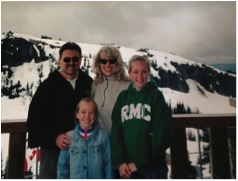 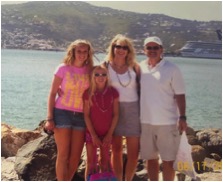
Picture Description: Above, Skylar (the shortest Lambert) attending the 2006 meeting in Whistler and the 2008 meeting in St Thomas. Below, Skylar is presenting her poster to past IBNS President, Dr. Robert Gerlai, and accepting the poster award from IBNS President, Dr. Scott Hall, at the 2019 IBNS meeting in Cairns, Australia.
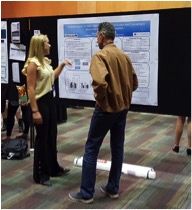 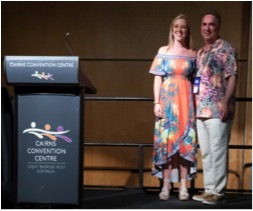
Back to Top
Science Down Under
Julianne Jett, PhD
Chair, IBNS Membership & Communications Committee
Outside of being at the forefront of scientific discovery, attending conferences gives us an opportunity to get out of the lab, travel and experience something different. For many, Australia is bucket list travel destination under the sub column titled ‘long shot’. However, for those in attendance at the 28th IBNS Annual Conference, the opportunity to mix a little pleasure (rather adventure) with business was simply too good to resist. Regardless if the conference destination was a few hours drive or a day’s travel to the other side of the world via plane, I hope that our attendees took a moment to step outside of your comfort zone and have a new experience… be that exploring a new town, trying different food, or connecting with the locals – human and wildlife alike. Check out some testimonies form our adventurous members!
Kim Gerecke, PhD
Associate Professor, Psychology and Behavioral Neuroscience
Randolph Macon College
One of the great bonuses of attending IBNS is that we get to go to places where you would love to visit. This year’s location of Australia was some place that I have always wanted to visit, so I took the opportunity to do some sightseeing beforehand. The trip from Sydney to the Blue Mountains was an especially great day, as we had tea surrounded by trees full of Kookaburra, Rainbow Lorikeets, and Cockatoos. A Mynah bird came and took crumbs from our biscuits, and I hand fed bits to semi tame White Cockatoos. I got up close to a Cassowary bird in a sanctuary, and hand fed Grey Kangaroos. It was an extraordinary experience to get to see so much wildlife in the wild, as well as to get to interact with creatures we consider fairly exotic here in the states. It was the trip of a lifetime, for sure!
David Amato, PhD
Assistant Professor, Department of Neuroscience
Medical University of South Carolina
I had a great meeting this year in Cairns! I attended the conference because I organize a symposium, which I enjoyed very much. However, Australia, as a location, was additional reinforcement to attend as I never been in Terra Australia before. Outside of the conference, one of the highlights of my experience was taking a sky rail trip through the Kuranda Rainforest. The experience was surreal as I had the feeling, for the first time in my life, of being in a real jungle. It was also nice to step away from business for a bit and to see something different. The town was lovely and I found the locals to be super kind, helpful and easy to engage in conversation in a way that I haven’t seen it in a long time.

Photo description: Kim Gereke’s up close and personal with a kangaroo and hungry cockatoos on the Sydney to Blue Mountain IBNS pre-tour. Davide Amato’s view of the Kuranda Rainforest from inside a sky rail.
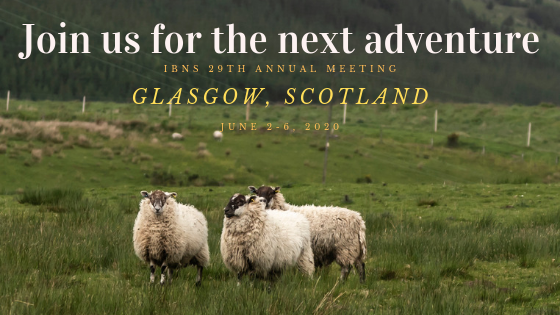
Back to Top
|